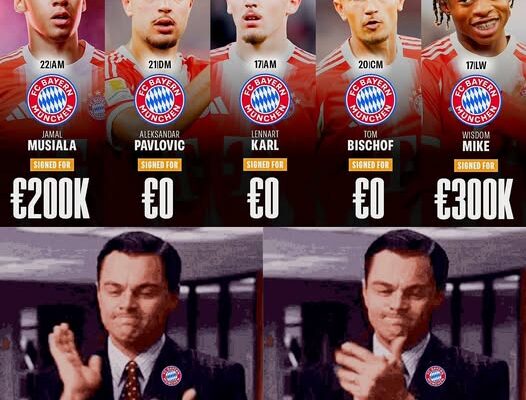Bayern Munich’s commitment to developing elite young talent has always been a defining feature of the club’s long-term sporting philosophy, but in recent years the emphasis has sharpened even further as the Bavarian giants seek to blend world-class recruitment with an academy system capable of supplying first-team players who understand the club’s culture at its core. Among the most exciting products and acquisitions of this vision are several German U23 players who, in different ways, embody the club’s renewed focus on technical skill, tactical intelligence, and long-term potential. These players represent not only Bayern’s future but also the promise of a new generation for the German national team. Their ages, transfer fees, and positions hint at interesting stories, but what truly stands out is how each fits seamlessly into the broader tactical evolution of a club constantly searching for the perfect balance between experience and youth.
Jamal Musiala, at 22, is already far more than an emerging talent; he is the crown jewel of Bayern’s youth-focused strategy and one of the most gifted attacking midfielders to emerge from Germany in decades. Signed for just €200,000—an almost unbelievable figure considering his current stature—Musiala’s trajectory has been meteoric. Though he once represented both England and Germany at youth levels, his decision to commit to the DFB now places him at the heart of the national team’s creative identity. What sets Musiala apart is not merely his ability to dribble past opponents with an elegance few players possess, but his intelligence in tight spaces, his timing when bursting into the box, and the rare calmness he exhibits whether he is facing defenders or balancing phase-of-play decisions in midfield. His role as an attacking midfielder, sometimes operating wider or deeper depending on Bayern’s structure, allows him to influence every layer of build-up. He plays between the lines, finds half-spaces instinctively, and makes defenders commit in ways that open attacking avenues for his teammates. Bayern’s modest investment in him remains one of the most astonishing bargains in modern football, and while the club has acquired countless stars for enormous fees, Musiala’s development from academy hopeful to superstar highlights the power of patience and belief in youth.
If Musiala is the creative heartbeat, Aleksandar Pavlovic represents the stabilizing force required to unlock such creativity. Signed for nothing—€0—because he rose through Bayern’s own youth system, Pavlovic’s emergence as a defensive midfielder has been one of the most encouraging developments for the club and for Germany, where the need for a new generation of deep-lying midfielders has become pressing. At 21, his game is defined by composure, tactical discipline, and a natural understanding of rhythm. He is not the type of midfielder who relies on physical dominance or aggressive tackles to control games; instead, Pavlovic dictates tempo through intelligent positioning, clean passing, and the ability to read danger long before it materializes. His presence allows Bayern to shift seamlessly between phases, turning defensive recovery moments into controlled build-up patterns. Pavlovic is the type of player who makes everyone around him better because he offers a dependable outlet under pressure, rarely loses the ball, and keeps transitions stable. Many Bayern academy products have shown promise over the years, but few have the strategic mindset and maturity Pavlovic displays at such a young age. His rise has been a reminder that even at a club filled with international stars, a calm, technically gifted holding midfielder developed in-house can become indispensable.
Lennart Karl, the 17-year-old attacking midfielder also signed for €0, represents the next generation still taking shape. At his age, potential is the driving narrative, but Karl has already demonstrated traits that make Bayern believe he could one day follow the path carved by Musiala. Creative attacking midfielders often require years of refinement because decision-making in the final third must be both instinctive and learned, but Karl shows an early understanding of when to pass, when to hold possession, and when to attempt something daring. His agility and quick footwork give him the ability to navigate tight spaces, while his vision unlocks opportunities other players his age might not even perceive. Though physically still developing, Karl’s style leans toward the modern hybrid playmaker who can float across multiple zones rather than being confined to a traditional No. 10 role. Bayern’s decision to bring him into their youth structure without a transfer fee reflects their confidence in his long-term ceiling. The club has always valued attacking midfielders who possess both technical precision and improvisational ability, and Karl seems to fit that mold. With patience, guidance, and the right developmental environment, he could become one of the next great academy graduates.
Tom Bischof, at 20 years old and also signed for €0, adds a different dimension to Bayern’s midfield profile. Originally developed at Hoffenheim before Bayern secured his signature, Bischof is a central midfielder with a blend of versatility, intelligence, and ball-progression ability that makes him an intriguing piece of Bayern’s long-term puzzle. Where Musiala thrives on flair and Pavlovic on control, Bischof offers a bridge between those styles. His passing range is excellent, his spatial awareness advanced for his age, and his ability to contribute both defensively and offensively makes him an ideal candidate for a modern multi-functional midfield role. He can operate as a No. 8, connecting phases of play, but he also has the capacity to drift into attacking zones, combine with forwards, and produce key passes. Bayern’s acquisition of him for no fee underscores both strategic scouting and the appeal the club holds for young Germans looking for elite development environments. Bischof’s game is defined less by flashy highlights and more by consistent contributions that elevate team fluidity, a trait coaches value immensely.
What ties all these players together is not only their nationality or their youth but the sense that Bayern is constructing a long-term midfield and attacking core around German talent once again. In the past decade, Bayern’s squad often leaned heavily on foreign imports—brilliant players, many of whom became icons—but the shift toward a homegrown and domestic foundation mirrors historical periods during which the club reached extraordinary heights. Musiala offers world-class creativity and match-winning unpredictability; Pavlovic provides structural balance; Bischof enhances fluidity and connection; Karl represents raw creative potential with years to grow. Together, they form a ladder of generational talent, each at different stages of development, each offering something distinct, and each reinforcing Bayern’s belief in nurturing youth rather than relying solely on expensive transfers.
Moreover, these players symbolize a new chapter for German football at a time when the national team has been searching for identity and renewal. The post-World Cup-2014 era has been marked by inconsistency, but the emergence of players like Musiala and Pavlovic has reintroduced optimism. Their stylistic profiles align with Germany’s need for dynamism, creativity, and tactical stability, qualities that had been lacking in recent cycles. Bayern’s heavy involvement in shaping these players is no coincidence; historically, the German national team reaches its highest levels when Bayern supply a strong core. By integrating young German talents into high-pressure environments early—Champions League nights, title races, tactical battles under top managers—Bayern are effectively shaping the backbone of the next national team generation.
Another critical element is the cost efficiency of these signings. Musiala’s €200,000 fee remains one of the most remarkable investments in modern football, but the fact that Pavlovic, Karl, and Bischof arrived for free underscores Bayern’s ability to identify talent early, recruit intelligently, and provide the right developmental pathways. In an era where elite clubs routinely spend tens or even hundreds of millions on young prospects, Bayern’s model emphasizes not only financial prudence but also institutional knowledge. By relying on a strong academy, strategic domestic scouting, and a clear footballing philosophy, the club reduces dependency on volatile transfer markets while ensuring long-term continuity.
As Bayern look to the future, it is easy to imagine a midfield and attacking structure shaped primarily by these young German talents. Musiala leading creative responsibilities, Pavlovic anchoring the midfield, Bischof connecting transitions, and Karl emerging as the next creative spark—this is not merely a theoretical projection but a realistic blueprint already unfolding. Each player will face challenges, competition, and the pressure inherent in representing a club with Bayern’s ambitions, but their profiles suggest readiness not only for development but for meaningful contribution.
In the end, Bayern Munich’s U23 German talents represent a rare blend of strategy, identity, and future-focused planning. They reflect a club refusing to be defined merely by its past successes and instead choosing to build a sustainable future rooted in youth, intelligence, and cohesion. For Germany, they symbolize hope; for Bayern, they symbolize continuity; and for football as a whole, they offer a reminder that even in an age dominated by massive transfer fees, some of the greatest success stories still begin with faith in young players and the belief that potential, when cultivated properly, can shape an entire era.



